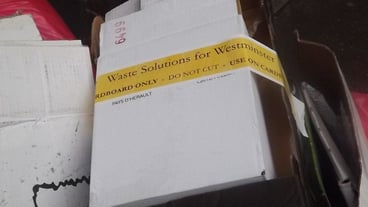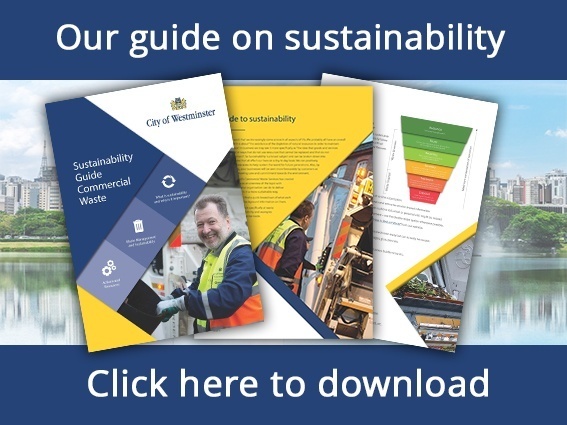 Cardboard is one of the most widely recycled materials in the retail and office sectors and many working there are already familiar with it. In Westminster, these two sectors produce the lion’s share of cardboard collected for recycling.
Cardboard is one of the most widely recycled materials in the retail and office sectors and many working there are already familiar with it. In Westminster, these two sectors produce the lion’s share of cardboard collected for recycling.
Thankfully, cardboard is one of the easier items to recycle and it is also a material in high demand. Paper and cardboard can be recycled up to seven times which helps save on raw materials, water and energy to produce new cardboard.
It also pays off to keep paper and cardboard segregated for recycling since the collection charges are much lower than for mixed recycling or general waste collections. Up to 65% of the average mixed recycling bag consists of paper and cardboard that can be easily segregated. Collecting large volumes of this material mixed with other recyclables is poor practice and as such it has been legally limited via the Waste Regulations 2011.
In this blog, we look at how your organisation can optimise the way that paper and cardboard are kept separated for recycling and how you can keep its quality high avoiding contamination.
What are the best ways to recycle cardboard?
For businesses that produce a large amount of paper and cardboard, it is best to use designated bins or a compacting baler. If your business is limited for space, then balers will enable you to compact your cardboard into small cubes that are easily stored and collected.
Businesses that only produce a small amount of cardboard can bundle this up and ensure it has a yellow cardboard sticker attached to it so can be put out for collection at the same time as your recycling bags.
Things to be aware of when recycling cardboard
Not everything can or should be recycled. Putting the wrong materials into your paper and cardboard recycling can cause whole truckloads to be useless for recycling. It is important to keep your paper and cardboard separate from other waste streams.
Four main types of waste often contaminate cardboard recycling:
- Food waste
- Food-soiled-packaging such as paper cups and sandwich boxes
- Polystyrene, wooden and plastic crates and boxes
- Hazardous waste such as batteries and paint
- Sanitary waste such as napkins and paper towels
Where is the cardboard which Westminster collects recycled?
All of the paper and cardboard that we collect is taken to DS Smith’s Kemsley Paper mill where it is turned into new packaging material.
DS Smith specialises in closed-loop recycling solutions meaning that cardboard can be back on the shop shelf within 14 days. To show you just how their operations work, DS Smith created a video showing you the DS Smith supply cycle.
Also, next year the mill will get its power and heat from a new EFW (energy from waste) facility built next door, meaning the mill will not be using any fossil fuel (natural gas) anymore to power the paper and cardboard recycling process.
Benefits of using our Commercial Waste Services for your paper and cardboard recycling
We take great pride in ensuring all of our services are as sustainable as possible. Paper and cardboard recycling is no exception. We insist on recycling our paper and cardboard to the highest standard possible. This means using a closed loop system which the most sustainable way to recycle cardboard. By using a closed loop system we can ensure that the cardboard is being used again as many times as possible. The material stays locally rather than exported abroad meaning it directly contributes towards local economic growth and employment.
Is this something any other waste operator can offer you?
One of the main reason businesses chooses us as their waste collector is due to our unrivalled environmental credentials.

Westminster City Council is a waste collection authority that sees us pick up waste and recycling in every street of Westminster regardless of who else might collect there. As such, it makes sense for us to collect as much waste as possible in one go eliminating any need to have more diesel fuelled waste trucks than is necessary down your street. Not only will this minimise harmful emissions, but it will also decrease congestion in Westminster.- Our trucks have a large capacity to collect a lot of waste in one go which avoids the need for unnecessary inefficient round trips as with smaller vehicles.
- The fleet of collection vehicles at Westminster City Council is much newer than many other operators fleets and features vehicles that do not use diesel.
If your business is looking to become more environmentally sustainable, then the best place to start is with our sustainability guide.
Our guide is made up of three parts.
- Part 1 covers the areas of sustainability that should be implemented into your plan, along with some advice on how to approach them.
- Part 2 draws from our deep experience of sustainable waste management, developed as one of the country’s largest Commercial Waste operators.
- Part 3 provides you with some practical actions that your business can take to improve your sustainability.


